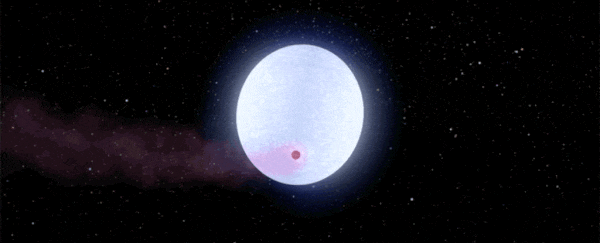Around 620 light-years away from Earth lies KELT-9b - by far the hottest planet we have ever found. It's so hot that vaporised iron and titanium are scattered throughout its atmosphere, as researchers discovered last year. But it turns out it gets even more intense.
Exoplanet scientists have now found a bunch of other vaporised metals swirling around KELT-9b - sodium, magnesium, chromium, and rare-Earth metals scandium and yttrium.
It's the first time chromium, scandium, and yttrium have been robustly detected in an exoplanet's atmosphere - a coup for the scientists at the Universities of Bern and Geneva who made the discovery.
"Our team predicted that the spectrum of this planet could well be a treasure trove where a multitude of species can be detected that have not been observed in the atmosphere of any other planet before," said astronomer Jens Hoeijmakers of the University of Bern.
KELT-9b is a huge oddball. It's a gas giant orbiting an extremely hot star extremely closely, around 3 percent of the distance between the Earth and the Sun. That star, HD 195689, is one of the hottest we know, a blue supergiant that burns at temperatures around 10,170 Kelvin.
The close proximity to its star gives the exoplanet an equilibrium temperature of around 4,050 Kelvin; on its day side, it's calculated to be approximately 4,600 Kelvin. That's actually hotter than some orange and most red stars, and just a little cooler than the Sun's surface temperature of around 5,800 Kelvin.
And these temperatures vaporise everything. All molecules are broken down into atoms, leaving not even clouds or aerosols - the atmosphere is being burned away. But it also means KELT-9b's atmosphere is like that of stars, completely transparent to light.
But, even completely vaporised, those atoms floating around in that hot, clear sky absorb specific wavelengths of light. By peering at the star with a spectrograph, which separates the light it detects into a spectrum, astronomers can look for those missing wavelengths and identify the elements that absorbed them.

This is how the team found iron and titanium in their first observing run. The second run has revealed the presence of the other five.
In addition to identifying what the elements were, the researchers were able to use the observations to work out altitudes at which they float in the planet's atmosphere, and infer global wind patterns that blow atoms between the two hemispheres.
The techniques used could help astronomers identify elements in the atmospheres of other planets - and, one day, could help us figure out answers to one of the Universe's most enduring questions: How and why is there life on Earth?
"The chances are good that one day we will find so-called biosignatures, i.e. signs of life, on an exoplanet, using the same techniques that we are applying today," said astrophysicist Kevin Heng of the University of Bern.
"Ultimately, we want to use our research to fathom the origin and development of the solar system as well as the origin of life."
The research has been accepted into Astronomy & Astrophysics, and is available on arXiv.
